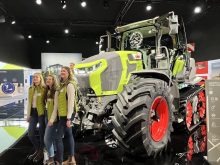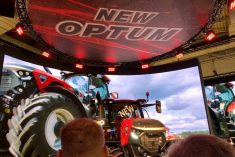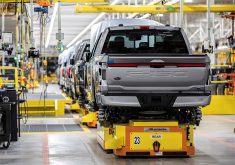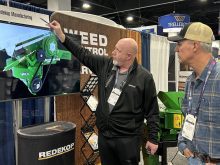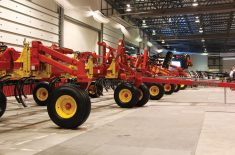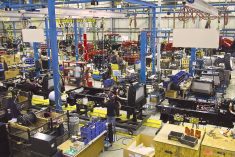I spent five days at Agritechnica 2023 and here are five things I learned. It’s a challenge sometimes to pull out the strong European policy influence on exhibitors and farmers at this show, but there are lessons for Canadian farmers, and the technology created to manage European problems in some cases will make economic sense here.
1. There are signs that the scale of farm equipment is hitting its maximum, not just for Europe.
Farm equipment around the world has continued to grow in size and weight. But that’s making it more difficult to get those machines down the road efficiently and a challenge to reduce the soil impact of more weight.
Read Also

Deere forecasts weak annual profit on tariff hit
Deere & Co forecast an annual profit below estimates on Wednesday, pressured by tariff impacts and weaker margins from its large tractors, sending the farm-equipment maker’s shares down nearly five per cent.
Two of the major product launches at Agritechnica were huge in their power potential, but they both included elements that showed that engineers were trying to get their size under control, even if the horsepower or throughput increased. Many people point to Europe’s narrow roads as a driver, but anyone operating a combine down a Canadian road also knows how challenging it’s become.
The New Holland CR11, is a massive machine, as are all modern combines. However the engineers at New Holland kept the physical size and weight the same as the CR10 models, despite adding significant horsepower (to 775) and threshing capacity (rotor length was increased by 50 per cent). They did this by changing the orientation of the engine to align with the direction and tilt of the rotors, and they then could drive some power down through the rotors to the front of the machine, instead of routing that power into belts outside of the main body of the combine.
Massey Ferguson’s new high horsepower 9S tractor has a range of 285 to 425 horsepower, but it weighs less than most other large tractors per horsepower. Massey is quick to point out that the tractor can carry a lot more weight if necessary, but it can be run lighter. It also has an option for a tire inflation adjustment system to reduce the impact on soil.
2. Autonomous power systems that perform their tasks in fields without humans continue to grow in number.
Numerous companies had prototypes or concepts at Agritechnica, including implement companies like Kuhn and Lemken. However, there are few autonomous units ready for the market. There are exceptions including Naio, the French company that makes robots mostly for horticulture markets and which has a number of its units operating in Ontario through Haggerty Ag Robotics. The company is currently building out its global dealer market, which means it has a product to sell.
AgXeed (pronounced as they told me Ag – ceed) is a Dutch company that is also building a dealer network as it now has units running in 20 countries and is making sales. AgXeed has three different units that would replace tractors in field situations versus Naio which is replacing mostly human tasks like weeding and crop monitoring. In discussion with both companies, it’s obvious that they’re thinking about liability, and safety, not just making the technology work, and I believe that for farmers to use the technology, they will need more of a partnership with their suppliers, as someone will have to set the boundaries of the field and whoever does that will take on some liability.
AgXeed is also thinking about standardizing the interface between implements and power units and has worked to create an independent organization with Claas and Amazone to help set those standards. The standards also would apply to the interaction between tractors driven by people in the same field as autonomous units to coordinate their operation.
This is an important step and shows maturity in the autonomy market. We all remember the many standards that existed as data started to be recorded in farm machines and how much of that data was siloed. Much of it has now been freed by more standardization and integrations.
3. There will be electrification in large machinery in the future, but most of the power will continue to be supplied by combustible fuels for large horsepower machines.
Several companies at Agritechnica showcased a variety of new engines, which will handle different types of fuel. Most major tractor companies now have most of their diesel engines that can also use biodiesel made from vegetable wastes or oilseeds. Many also now have hydrogen engines in development, along with hybrids. Hybrid cars operate by supplementing the highest fuel demand periods with electricity and tractors and combines will likely do the same. That’s for high-horsepower tractors. For those under 100 hp, there will be a cascade of electrified options, as many companies, from CaseIH to John Deere to Claas, Kubota, Fendt, Landini and others we don’t see in much North America like Tafe, had under 100 HP electrified tractors on their displays.

4. There are increasing numbers of sensors being added everywhere in agriculture equipment, but at some point I expect there will be some of them that won’t last in the market as they won’t make financial sense. Take Fendt’s mower conditioner which can add more conditioning to areas of a hay field with more biomass.
There are currently three ways the Fendt conditioner will work: 1. By the operator in the cab turning it on depending on what they observe in the field. 2. By sensing with a drone and through a map set and with that data loaded into the tractor path control and 3. On-board sensors that measure biomass as the tractor mows through the field. I’m going to guess that the operator sensor will be the simplest, easiest and most economical.
5. As one of the world’s leading exporters of agricultural products, Canada should have a larger influence outside of the country in machinery and services. Some large Canadian agriculture companies came to play at Agritechnica, including grain storage company AGI and MacDon, which continues to grow its influence around the world as the draper head expert. A MacDon head is on the new New Holland CR11 combine for example.
But maybe Canadian influence doesn’t have to be in machinery, maybe it can be in targeted expertise. Bushel Plus, the agile and creative startup from Manitoba that started with a pan to measure grain loss from combines, now has 30 employees and is offering combine training around the world, from Europe to Australia to the southern United States.
– John Greig is a senior editor with Glacier FarmMedia. Watch for much more detail on these and many more stories and videos from Agritechnica in our Glacier FarmMedia newspapers and websites.




